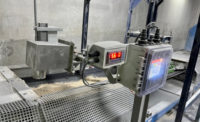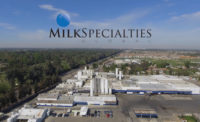
Time to Automate
From labor savings to just-in-time inventory, automation
is the wave of warehousing’s future.
by Shonda Talerico Dudlicek
Space has always
been at a premium in most dairy processing plants. With necessary machinery
taking up a huge part of a facility’s overall footprint, processors
need to make the most of the space they do have for warehousing — all
the while attempting to cut down the time products actually remain stored.
Robotics is playing a large part in automated
storage and retrieval (ASR) systems, which by itself is a big leap that
many dairy processors are reluctant to take because of the initial expense.
But as suppliers point out and processors are discovering, the benefits of
an ASR system far outweigh the start-up costs.
“There are many, many dairy operations
that are looking at automation but are unsure whether it’s right for
them,” says Dan Labell, president, Westfalia Technologies, York, Pa.
Automated systems can be built higher, saving on
space and construction cost. “We find in many applications we’re bidding
right now, by the time you add the conventional construction costs of the
additional building space required, you’re paying for a significant
amount of the machinery. Yet many people invest in more brick and mortar,
which doesn’t save you operating costs such as labor, product damage
or accuracy,” Labell says. “In addition, the depreciation of a
building is 39 years. On a machine it’s seven years. There’s
obviously some
tax advantages in investing more in automation and machinery rather than a
building.”
Westfalia Technologies specializes in ASRs, and Labell says his
company’s systems are unique because of their design. Customized
systems can range as high as 120 feet or as low as 15 feet, depending on a
plant’s needs. “We provide the warehouse management systems, so
the software supports the systems as well as conveyors and other material-handling
equipment to bring product from manufacturing or receiving into a warehouse
and then we provide automated order-selection systems so that one can pick
orders to the unit level,” he says.
Westfalia’s newest ASRs are rail-driven and allow
for a narrower aisle — about 5 feet, 3 inches wide, compared to 9- to
12-foot widths found in most warehouses. The company’s storage
retrieval machine operates in a narrower space because it doesn’t
have to turn around, and it can store a pallet to its left and right sides without having to
rotate itself in the aisle, like a forklift would have to, Labell explains.
“The aisle doesn’t have to be much wider than the pallet
itself,” he says.
Oregon’s Tillamook County Creamery Association
and Hershey Creamery Co., Harrisburg, Pa., utilize Westfalia’s
satellite technology for its ASRs. Westfalia ASRs were installed in Tillamook’s recent
warehouse expansion, adding a 15,000-pallet position system. At Hershey,
Westfalia built a 7,500-pallet-position automated warehouse with integrated
order selection, and recently expanded it by about 50 percent. With satellite technology, which
retrieves pallets from a rack structure and is best for high-density
applications, this flexibility allows for storage lanes to be anywhere from one to 12
pallets deep.
Assessing Needs
With dairies, saving time is always a challenge.
Processors seeking to compress the time schedule for loading their trucks
with finished fluid product can look to automation.
“I think most of our applications have similar problems. They are
trying to get their products to their customers in the most efficient
manner and the shortest amount of time. So usually the challenges are in
how can we take this space and create a load-out/shipping system that can
perhaps load out in 10 hours instead of 18,” Labell says, referring
to a recent project for Danone in Argentina and Santee Dairies in City of
Industry, Calif.
When determining a processor’s needs,
there are questions a supplier needs to ask, Labell says. “How many
gallons of milk or pounds of cheese or pallets of product are they storing?
How do we get that into the space required? How many machines do we need to
handle the throughputs, for example, the volume the plant will produce? How
do we integrate the possible order selection systems within the distribution center
— meaning I don’t just ship pallets, I also ship cases and
perhaps even individual units,” he says. “How do I get those to
my customers and how do I do that in the most efficient manner?”
Ready to take warehousing technology a step
further, Westfalia is rolling out pallet-less multiple deep-layer storage
and retrieval systems, for those operations desiring automated layer
picking. What makes the multiple deep-layer load system unique
is its use of a storage rack support member under each layer, rather than a
pallet to
support the layer, Labell says.
“Each pallet is broken down into layers
using a robot with a de-palletizing end-effecter,” he explains.
“Now imagine putting them in a storage system one layer at a time and storing these layers
without a pallet.”
Westfalia’s new ASR system is designed to
accommodate fluid products shipped in 16- or 24-quart plastic dairy cases.
The system also handles palletized product so cases of fluid product and
palletized loads of corrugated product can be handled within the same system.
Customers can store and retrieve product in
layers, and Westfalia’s new ASRs will offer automated retrieval of layers to form a
“rainbow/mixed” pallet that’s been picked automatically
without human intervention.
“If you were to use a pallet below every
single layer, you would probably have thousands of extra pallets that you
would have to handle,” Labell says. “If every layer had a
pallet underneath and you bring that layer out, you would have to take the product off the
pallet, and you’d
be left with the empty pallet. Now what do you do with it? You have to
reclaim it somehow, stack it back up again. It takes a lot more equipment
and more space, so keeping the pallet out of it would be an
advantage.”
Because Westfalia’s multiple deep system has the
ability to store up to 10 pallets deep on either side of the aisle,
it’s geared toward dairy processors who produce in larger-lot
quantities. Individual
case picking and unit picking can easily be integrated within this layer
AS/RS. Layers are automatically replenished on demand and presented to the
order picker. The selection face can have as much as four or five products
within a typical 40-inch selection face, compared to just one for a full
pallet.
Maximizing Efficiencies
Like its name suggests, the backbone of Dairy
Conveyor is conveyors, but the Brewster, N.Y.-based company can design a
conveyor curve or implement and execute an entire system, including
automatic packaging equipment for milk and ice cream. Processors usually
call on the company’s expertise in dairy when they want to add
another line or achieve more flexibility to run multiple products on the
same line, increasing the utilization of existing equipment, says Paul
Calabretta, new business developer for the company’s West Coast
division in Huntington Beach, Calif.
“Space in milk plants is always an issue
because they usually have very confined processing areas. I think one of
the advantages we have is that our conveyor systems evolve from a lot of
thought, and we differentiate ourselves by creating a custom or a unique
path to allow the operators greater room to move around in a very tight
environment,” Calabretta says. “Our systems are designed to
maximize space utilization because we’re primarily linked to dairy.
We don’t really do beverages or snack foods. We understand what milk
plants face because we’ve been working with them for 50 years.”
Dairy processors often ask for ways to maximize
efficiencies, Calabretta says. “They’ll ask for an accumulation
conveyor system to allow equipment to run longer without shutting it down
in the event of a problem,” he says. “But multiple product
conveying and accumulation are probably the two main drivers
recently.”
Calabretta says he sees more regional requests
for automatic equipment to run two case sizes, 24- and 16-quart milk cases,
primarily on the East and West coasts.
Dairy Conveyor recently introduced the Dairy
Management System, an inventory-control system that ties into its
conveyors, and vacuum conveyors for empty bottles. “Vacuum conveyors
are something that other vendors manufacture, but we had not until this
yea, so we’re doing that now to kind of round out our product
line,” Calabretta says. “Vacuum conveyor is becoming a little
more popular because of the round, unstable bottles that are coming into
the marketplace.”
To help dairy processors achieve just-in-time
inventory practices, Calabretta sees automated palletizing and banding as
the latest automation trends. In banding, the palletizer wraps two strips
of plastic band, similar to a belt, around the top and second or middle
case in a typical 62-inch-tall, six-crate-high pallet. “Since stacks
of milk cases are unstable, they usually need to be banded together, so
usually when you sell an automatic palletizer you probably sell a bander as
well. It basically squeezes the milk stacks together so it stays put
without falling over,” Calabretta says.
Banding is starting to replace shrink wrapping
in the warehouse because of disposal issues, he says. “Banding is
cheaper because shrink-wrap machines not only take up a lot of space but
they provide a lot of waste, too. There’s a lot less hassle and these
banders take up such little space. The most amount of room they take is for
the rolls for the banding, but other than that they’re almost
invisible. This machine integrates right into the palletizer.”
Mark Hanson, director of marketing, at
Rosemount, Minn.-based Cannon Equipment, says processors are requesting
ways to make tracking product easier from fill point to load out.
“This can be in the form of scanners, hand-held radio frequency units
and other tracking systems,” Hanson says. Cannon is developing a
gravity case loader that cases multiple sizes of product and container
sizes with minimal adjustments.
During a recent project, Cannon was asked to
develop a milk cart loader that would be able to load either 80-gallon or
120-gallon carts. “This was due to the changes in the way our
processor customer is servicing its customers,” Hanson says, adding
that the changeover was as simple as the turn of a switch.
“Customers are looking for a supplier that
is capable of being a one-source supplier, able to supply turn-key
installations. Cannon provides sales, system design, custom equipment
design, electrical and programming, manufacturing, installation and start
up all in our own facilities. Customers also demand equipment with much
higher speeds than in the past. Custom-design systems to handle the
customers’ changes in the products they manufacture and the shipping
containers they ship in.”
Cannon Equipment offers material-handling system
design and in-house system engineering, programming staff and the ability
to manufacture its own equipment from raw material into finished product,
Hanson says.
Recent installations include automatic equipment for case and
stack handling and a cart-handling system, “where we elevate full bottles
overhead, where they travel across the facility to the cart-loading area, where
they are brought back down to floor level,” Hanson says. “This frees
up a tremendous amount of floor space to leave room for other needed processes.”
df
Shonda Talerico Dudlicek is a freelance journalist and a former managing editor of Dairy Field.
Shonda Talerico Dudlicek is a freelance journalist and a former managing editor of Dairy Field.
Ice Cream of the Crop
Dairy Field’s sister magazine honors Good Humor-Breyers
Ice Cream for excellence in logistics.
I scream. You scream. We all scream for ice
cream. It doesn’t matter whether it’s the peak of the
summertime season or a momentary impulse buy. Ice cream and novelty
processors know that success means having product available when and where
the consumer wants it. Then again, the same measures apply to pleasing
retail customers, everyone from the local convenience store and
neighborhood ice cream truck to the area’s local supercenter
retailer.
Suffice it to say that for all the fun and frivolity
associated with it, ice cream is a serious business behind the scenes. And
perhaps no company excels at the logistics side of the equation as does
Good Humor-Breyers Ice Cream, winner of Refrigerated & Frozen Foods’
fourth annual Logistics Leadership Award.
Headquartered in Green Bay, Wis., Good
Humor-Breyers (GHB) is a dairy industry leader with an estimated $1.3
billion in annual sales. An operating unit of Unilever, GHB offers ice
cream and novelties under five leading brands including Klondike, Good
Humor, Breyers, Popsicle and Ben & Jerry’s.
Good Humor-Breyers ships more than 700,000 pallets of
product annually from seven public refrigerated warehouses serving as
regional distribution centers nationwide. Most are located in close
proximity to the company’s nine processing plants.
In discussions with R&FF, a majority of
third-party warehouse, transportation and logistics services providers
selected GHB as one of the supply chain’s most proactive
processor-shippers during the past year. Voting criteria spanned everything
from collaborative planning to product-pallet integrity and carrier
relations.
R&FF editor Bob Garrison presented
R&FF’s award to GHB during the American Frozen Food
Institute’s annual Distribution and Logistics Conference in San
Diego.
“For us this is everyday business. Yet
it’s nice to know that we’re recognized as a leader among our
peers. I look forward to taking this back to our [logistics] team and
sharing this with them. It’s an honor,” said Kirk Heissel, GHB
director of logistics and one of two company executives on hand for a
moderated discussion about the company’s logistics practices.
Keeping their Cool
Such an industry accolade may be a sweet reward for a busy logistics
team.
Traveling with Heissel was Joe Klim, senior manager of logistics
and customer service. Asked about the past year’s achievements, Klim said
GHB recently integrated Ben & Jerry’s inventory and direct store delivery
system into Good Humor-Breyers’ wider warehouse-based distribution center
network.
“Our customers now have the ability to have all five of our brands delivered on the same truckload,” noted Klim.
“Our customers now have the ability to have all five of our brands delivered on the same truckload,” noted Klim.
No less demanding was another project to integrate the
supply chain for Canada with the U.S. business and relocate that system
into Green Bay. Thus, Klim’s group has begun controlling the entirety
of the customer service, distribution and transportation for all products
sold in the United States and Canada.
“It’s been a challenging year and a year
of change but that’s what makes logistics exciting,” said Klim.
“Ben & Jerry’s added substantial volume and that came on
top of significant annual internal growth. It’s been a big year of
change and our DC and carrier partners really helped us handle the
growth.”
Speaking of growth, Heissel said GHB routinely
introduces between 40 and 60 new items each year across its many ice cream
and novelty lines. The past 12 months have not been an exception and volume
for a new Klondike® CarbSmart line has grown by triple digits since the line’s
debut last September, Heissel said. Another volume leader are new grocery
multi-packs with double-digit sales increases.
Preventing Meltdowns
How does GHB avoid supply chain meltdowns in the midst of so
much activity?
“Good Humor-Breyers is very organized. They know
when their product is to arrive, what the load contains and they use
carriers with proven records of on-time deliveries,” said one
warehouse operator-voter.
Located in the Pacific Northwest, the voter continues,
“They are completely [oriented toward] electronic data interchange.
All inbound and outbound orders are [communicated electronically] several
times daily and any disruption is caught and corrected immediately . . .
They are proactive in working with the distribution center to plan volumes,
anticipate needs and work through issues to better service the end
customer.”
From one end of the nation to the other, a Southern
distribution center operator agrees, “Good Humor Breyers is a leader
in this area with consistent benchmark performance levels in inventory
control and case/order fill rates to their customers. They proactively
provide accurate inventory level forecast reports to our company throughout
the year.
“This forecast information allows our
company to optimize space utilization levels at our facility. GHB fully
integrated a significant piece of new business (Ben & Jerry’s)
into their existing distribution network with little or no disruption to
the business or decline in customer service performance levels.”
For their part, GHB officials are looking to still
improve. Noted Klim, “It would be nice to ship everything out in the
same way we move it around in our system – in nice full pallets
– but customers are demanding more each day, Whether it involves case
picking or modular pallets, we’re seeing customers shift more of the
inbound work to us.
“Our challenge is to manage these changes effectively
and that means getting better information, sooner, and sharing it with our partners.
We will continue to to evolve and change the way we do things to get the job
done right.
$OMN_arttitle="Time to Automate";?>

